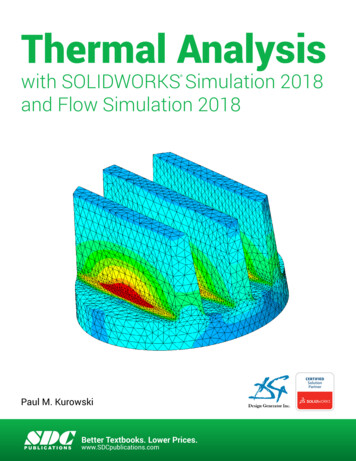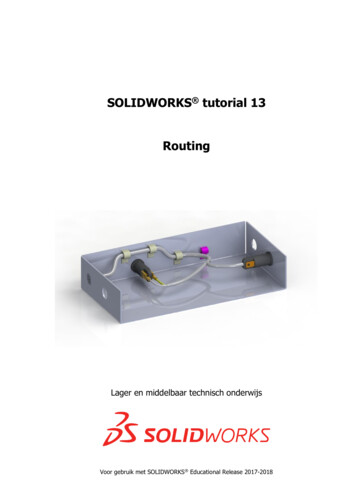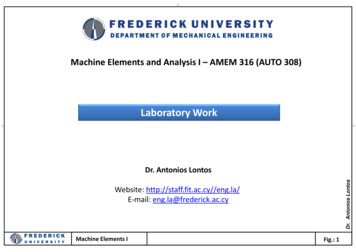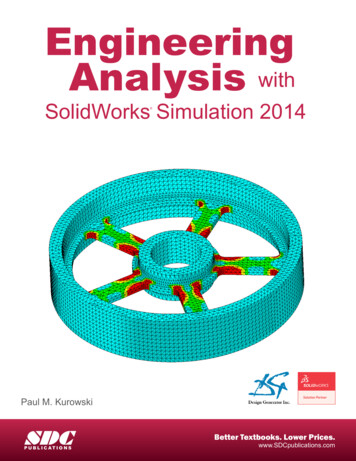
Transcription
Thermal Analysiswith SOLIDWORKS Simulation 2018and Flow Simulation 2018 Paul M. KurowskiSDCP U B L I C AT I O N SBetter Textbooks. Lower Prices.www.SDCpublications.com
Visit the following websites to learn more about this book:Powered by TCPDF (www.tcpdf.org)
Thermal Analysis with SOLIDWORKS Simulation 20181: IntroductionTopics covered Heat transfer by conductionHeat transfer by convectionHeat transfer by radiationThermal boundary conditionsAnalogies between thermal and structural analysisThermal elements: solids and shellsScalar and vector entities, presenting resultsSteady state thermal analysisTransient thermal analysisLinear thermal analysisNonlinear thermal analysisWhat is Thermal Analysis?Thermal analysis deals with heat transfer in solid bodies. We approach thermalanalysis from the perspective of a user experienced in structural analysis such asstatic, modal, buckling etc. as implemented in SOLIDWORKS Simulation. Youwill soon notice that experience in structural analysis is directly transferable tothermal analysis because of the close analogies between structural and thermalanalyses. The temperature is analogous to displacement in structural analysis,strain to temperature gradient, and stress to heat flux. Selected analogies aresummarized in Figure 1-1.5
Thermal Analysis with SOLIDWORKS Simulation 2018Structural AnalysisThermal AnalysisDisplacement [m]Temperature [K]Strain [1]Temperature gradient [K/m]Stress [N/m2]Heat flux [W/m2]Load [N] [N/m] [N/m2] [N/m3]Heat source [W] [W/m] [W/m2] [W/m3]Prescribed displacement [m]Prescribed temperature [K]Pressure [N/m2]Prescribed heat flux [W/m2]Hook’s law:Fourier’s law:𝑑𝑑𝑑𝑑𝜎𝜎 𝐸𝐸𝑑𝑑𝑑𝑑𝑞𝑞 𝑘𝑘Stiffness matrixConductivity matrix𝑑𝑑𝑑𝑑𝑑𝑑𝑑𝑑Figure 1-1: Analogies between structural and thermal analyses with units in SIsystem.The primary unknown in structural analysis is displacement; the primaryunknown in thermal analysis is temperature. This leads to an important differencebetween structural and thermal analysis performed with the finite elementmethod. Displacement, which is a vector and includes both translation androtation, requires up to six degrees of freedom per node. The number of degreesof freedom in structural analysis depends on the type of elements; for example,solid elements have three degrees of freedom per node and shell elements havesix degrees of freedom per node. Two-dimensional structural elements have twodegrees of freedom per node. Temperature is a scalar and requires only onedegree of freedom per node, regardless of element type. This makes thermalproblems much easier to solve because thermal models typically have fewerdegrees of freedom as compared to structural models.6
Thermal Analysis with SOLIDWORKS Simulation 2018Another conceptual difference is that thermal analysis is never a “static” analysis.If heat flow does not change, then the problem is “steady state analysis” and notstatic because heat flow never stops. If heat flow changes with time, then theproblem is called transient.Mechanisms of heat transferConductionIn a solid body, the energy is transferred from a high temperature region to a lowtemperature region. The rate of heat transfer per unit area is proportional to thematerial thermal conductivity, cross sectional area and temperature gradient inthe normal direction; it is inversely proportional to the distance (Figure 1-2). Thismode of heat transfer is referred to as � 𝑘𝑘𝑘𝑘(𝑇𝑇𝐻𝐻𝐻𝐻𝐻𝐻 𝑇𝑇𝐶𝐶𝐶𝐶𝐶𝐶𝐶𝐶 ��𝐶 – Heat transferred by conduction [W]k – Thermal conductivity [W/m/K]𝐴𝐴 – Cross sectional area [m2]𝑇𝑇𝐻𝐻𝐻𝐻𝐻𝐻 – Temperature on the hot side [K]𝑇𝑇𝐶𝐶𝐶𝐶𝐶𝐶𝐶𝐶 – Temperature on the cold side [K]𝐿𝐿 – Distance of heat travel [m]Conduction is responsible for heat transfer inside a solid body.7
Thermal Analysis with SOLIDWORKS Simulation 2018TCOLDTHOTLFigure 1-2: Heat transfer by conduction.Conduction is responsible for heat transfer inside a solid body.Thermal conductivity is vastly different for different materials as shown inFigure 1-3.Thermal conductivity [W/m/K]Figure 1-3: Thermal conductivity for different materials.There are five orders of magnitude difference in thermal conductivity betweenthe best conductors and best insulators.8
Thermal Analysis with SOLIDWORKS Simulation 2018ConvectionConvective heat transfer is the heat flow between a solid body and thesurrounding fluid (either liquid or gas). Convective heat transfer can be eithernatural convection where the fluid flow is due to the variation in specific weightof a hot and cold fluid, or forced convection where the fluid is forced to flow pastthe solid body. Therefore, natural convection requires gravity (Figure 1-4), andforced convection does not require gravity (Figure 1-5). Since fluid (air, water,steam, oil etc.) is required for heat transfer by convection, this type of heattransfer cannot happen in a vacuum. Heat exchanged by convection is �� ℎ𝐴𝐴(𝑇𝑇𝑆𝑆 𝑇𝑇𝐹𝐹 )Where:𝑄𝑄𝐶𝐶𝐶𝐶𝐶𝐶𝐶𝐶 – Heat transferred by convection [W]ℎ – Convection coefficient [W/m2/K]𝐴𝐴 – Surface area [m2]𝑇𝑇𝑆𝑆 – Surface temperature [K]𝑇𝑇𝐹𝐹 - Fluid bulk (ambient) temperature [K]𝑇𝑇𝐹𝐹 - Bulk temperature of fluid in contact with surfaceGravityCooler fluid descendsWarmer fluid rises𝑇𝑇𝑆𝑆 - Surface temperatureFigure 1-4: Heat transfer by natural convection.Convective heat transfer can take place only in the presence of fluid and gravity.9
Thermal Analysis with SOLIDWORKS Simulation 2018BlowerCold airCold airForced convectionNatural convectionFigure 1-5: Natural and forced convection.Forced convection does not require gravity.The magnitude of the convection coefficient strongly depends on the medium(fluid) surrounding a solid body (Figure 1-6).Convection coefficientMediumW/m2/KAir (natural convection)5-25Air/superheated steam20-300Oil (forced convection)60-1800Water (forced convection)300-6000Water (boiling)3000-60000Steam (condensing)60000-120000Figure 1-6: Convection coefficient for different media.There are five orders of difference in convection coefficients between differentmedia and different types of convection.10
Thermal Analysis with SOLIDWORKS Simulation 2018RadiationRadiation heat transfer occurs between a solid body and the ambient or betweentwo solid bodies without presence of any medium (fluid). This is the only type ofheat transfer that occurs in a vacuum. Heat flows by electromagnetic radiation.The upper limit to the emissive power is a back body radiating heat and isprescribed by the Stefan-Boltzmann law:𝑞𝑞 𝜎𝜎𝑇𝑇𝑠𝑠4Where:𝑞𝑞 – Heat flux (heat emitted by radiation per unit of area) [W/m2]𝜎𝜎 – Stefan-Boltzmann constant 5.67x10-8 [W/m2/K4]𝑇𝑇𝑠𝑠 – Surface temperature [K]The heat flux emitted by a real surface is less than that of a black body at thesame temperature. It is given as:𝑞𝑞 𝜀𝜀𝜀𝜀𝑇𝑇𝑠𝑠4where ε is a radiative property of a surface called emissivity. Values of ε are inthe range of 0 ε 1 and provide a measure of how well the surface emitsradiative energy in comparison to a black body. It depends strongly on thesurface material and finish. For example, a polished aluminum surface has anemissivity of about 0.05; an oxidized aluminum surface has an emissivity of 0.25.The emissivity also depends on the temperature of the face emitting heat byradiation.In heat transfer by radiation, heat may be radiated out to space by a single body;it may be exchanged between two bodies or it may be exchanged between twobodies as well as radiated out to space (Figure 1-7).11
Thermal Analysis with SOLIDWORKS Simulation 2018(1)Heat radiated out to space(2)Heat radiated from one bodyto another body(3)Heat radiated from one bodyto another body and to spaceFigure 1-7: Different cases of heat transfer by radiation.If heat is exchanged between two bodies only and not radiated out to space, thenone body must be fully enclosed by the other body (2). Heat gained by radiationmay be radiated out again into space (3).Having introduced three mechanisms of heat transfer we need to make a veryimportant statement. With SOLIDWORKS Simulation which uses the finiteelement method, only heat transfer by conduction is modeled directly.Convection and radiation are modeled as boundary conditions. This is done bydefining convection and/or radiation coefficients to faces that participate in heatexchange between the model and the environment.The next two examples show how a prescribed temperature, convection and heatload work together to induce heat flow inside a solid body. These examples arenot hands-on exercises. Hands-on exercises will start in chapter 2.12
Thermal Analysis with SOLIDWORKS Simulation 2018Heat Flow Induced By Prescribed TemperaturesJust like stresses may be caused by prescribed displacement, heat flow may beinduced by temperature differences defined by prescribed temperatures. Considerthe model BRACKET TH with different temperatures defined on two faces asshown in Figure 1-8. Note that the temperature field establishes itself in themodel but heat flow continues due to temperature gradients. Also notice that noheat escapes from the model because we have not defined any mechanism toexchange heat through any surfaces other than the two faces with prescribedtemperatures. This implies that the model is perfectly insulated, except for twofaces where prescribed temperatures are defined and may correspond to asituation where the bracket holding a hot pipe is mounted on a cold surface andheat escaping through faces exposed to air is negligible.Back face 20 CCylindrical face 300 CFigure 1-8: Temperature distribution in the model where heat flow is induced byprescribed temperatures.A temperature of 300 C is applied to the cylindrical face, and a temperature of20 C is applied to the back face.Plot in Figure 1-8 uses custom colors (grey substituted for blue) to improve theblack and white print quality. Custom colors will be used frequently to presentfringe plots in this book. Custom colors may be defined in Chart Options in plotsettings.13
Thermal Analysis with SOLIDWORKS Simulation 2018Heat flow induced by heat load and convectionHeat flow can also be induced by the applied heat load. The unit of heat loadapplied to a surface is called heat flux; heat flowing through an imaginary crosssection is also called heat flux. Total heat applied to a volume or face is calledheat power. Notice that since thermal analysis deals with heat flow, a mechanismfor that heat flow to occur must be in place. In the heat sink problem HEATSINK01, shown in Figure 1-9, heat enters the radiator model through the base, asdefined by the applied heat power which is a close analogy to force load instructural analysis. Convection coefficients [W/m2/K], also called filmcoefficients, are defined for all remaining surfaces and provide the way toremove heat from the model; ambient temperature must be also defined.Heat enters the model through the base where heat power is defined. Heatescapes the model through faces where convection boundary conditions aredefined; definition of convective boundary conditions consists of definition ofconvection coefficients and ambient temperature, which is temperature of thesurrounding fluid.Heat powerdefinedon this faceHeat flux plotTemperature plotFigure 1-9: Temperature distribution and heat flux in a heat sink model.A temperature plot being a scalar quantity can only be shown using a fringedisplay. Heat flux is a vector quantity and can be illustrated either by a fringeplot or by a vector plot. Notice that arrows “coming out” of the walls illustrateheat that escapes the model because of convection.14
Thermal Analysis with SOLIDWORKS Simulation 2018The structural analogy of convection coefficients is a bit less intuitive.Convection coefficients are analogous to elastic support offered by distributedsprings. Just like supports and/or prescribed displacements are necessary toestablish model equilibrium in a structural analysis problem, convectioncoefficients and/or prescribed temperatures are necessary to establish heat flow ina thermal analysis problem. Indeed, an attempt to run thermal analysis with heatloads but with no convection coefficients or prescribed temperatures results in anerror similar to the one caused by the absence of supports in structural analysis.Modeling considerations in thermal analysisSymmetry boundary conditions can be used in thermal analysis based on theobservation that if symmetry exists in both geometry and boundary conditions,then there is no heat flowing through a plane of symmetry. After simplifying themodel to ½ in case of single symmetry or to ¼ in case of double symmetry(Figure 1-10), nothing needs to be done to surfaces exposed by cuts. Noconvection coefficients defined for those surfaces means that no heat flowsacross them.Full model½ model¼ modelFigure 1-10: Model DOUBLESYM with double symmetry can be analyzed using¼ of the model.No thermal boundary conditions are applied to faces in the plane of symmetry.15
Thermal Analysis with SOLIDWORKS Simulation 2018Axisymmetric problems may be represented by 2D models as shown in Figure 111.Axis of symmetryFull model2D cross section along the axis of symmetryFigure 1-11: Axisymmetric model AXISYM represented by a 2D cross section.Notice that models DOUBLE SYM (Figure 1-10) and AXISYM (Figure 1-11)are suitable for analysis of temperature, but because of sharp re-entrant edges,they are not suitable for analysis of heat flux near the sharp re-entrant edgesbecause heat flux there is singular. This is in direct analogy to sharp re-entrantedges causing stress singularities in structural models.Once you acquire sufficient familiarity with thermal analysis you are encouragedto analyze models BRACKET TH, HEAT SINK01, DOUBLE SYM, AXISYMusing thermal parameters of your choice.16
Thermal Analysis with SOLIDWORKS Simulation 2018Let’s wrap up this review with an important observation which will serve as aguide to all thermal analysis problems. In structural analysis we define a loadpath by defining loads and supports. In a heat transfer problem, we define amechanism of heat transfer; we must know how heat enters the model, how ittravels through the model and how it exits the model.Types of thermal analysisThermal analysis may be linear or nonlinear, steady state or time-dependent asshown in Figure 1-12.Are material propertiesor boundary conditions temperaturedependent?NoYesLinear analysisNonlinear analysisTime-dependent?Time-dependent?NoYesLinear steadystate analysisNoLinear transientanalysisNonlinear steadystate analysisYesNonlinear transientanalysisFigure 1-12: Types of thermal analyses.In linear analysis, the conductivity matrix does not change during the solutionprocess; in nonlinear analysis it must be modified because material propertiesand/or boundary conditions are temperature dependent. In steady state analysis,material conditions and boundary conditions do not change with time; in timedependent (transient) they do change.17
Thermal Analysis with SOLIDWORKS Simulation 2018Thermal analysis with SOLIDWORKS SimulationSOLIDWORKS Simulation uses methods of finite element analysis to solveboth structural and thermal problems. CAD models prepared in SOLIDWORKSare discretized (meshed) into finite elements which type depends on the type ofgeometry prepared in SOLIDWORKS. Solid bodies are meshed into solidelements; Surface bodies are meshed into shell elements; 2D axisymmetric andextruded models are meshed into corresponding 2D elements. Types of finiteelements, meshing techniques and other mesh specific considerations arediscussed in detail in the pre-requisite text “Engineering Analysis withSOLIDWORKS Simulation.” Here we limit our review to thermal analysisspecific issues.Elements available in thermal analysis with SOLIDWORKS Simulation areshown in Figure 1-13. Notice that beam elements are not available in thermalanalysis.3D elements2D elementsAxisymmetricelementsSolid elementsShell elementsExtrudedelementsFirst order elementLinear (first order)temperature fieldConstant heat flux fieldSecond order elementParabolic (second order)temperature fieldLinear heat flux fieldFigure 1-13: Elements available in thermal analysis with SOLIDWORKSSimulation.The majority of analyses use the second order solid tetrahedral elements.18
Thermal Analysis with SOLIDWORKS Simulation 2018First order elements do not offer any advantages in either structural or thermalanalysis and beam elements are neither applicable nor available in thermalanalysis. Therefore, we are left with second order solids and second order shellsto model 3D problems and second order plate elements to model 2Daxisymmetric or extruded problems.Prior to commencing work with thermal problems, make sure that Solid Bodiesand Surface Bodies are visible in the SOLIDWORKS Feature Manager (Figure1-14).Figure 1-14: Settings of Feature Manager.To facilitate working with Simulation models make Solid Bodies and SurfaceBodies always visible.19
Thermal Analysis with SOLIDWORKS Simulation 2018Models used in this chapterModelConfigurationBRACKET THDefaultHEAT SINK 01Default01 fullDOUBLE SYM02 half03 quarterAXISYMDefaultFigure 1-15: Names of models and model configurations used in this chapter.You are encouraged to analyze these models using thermal analysis settings ofyour choice.20
Thermal analysis deals with heat transfer in solid bodies. We approach thermal analysis from the perspective of a user experienced in structural analysis such as static, modal, buckling etc. as implemented in . SOLIDWORKS Simulation. You will soon notice that experience in structural analysis is directly transferable to










